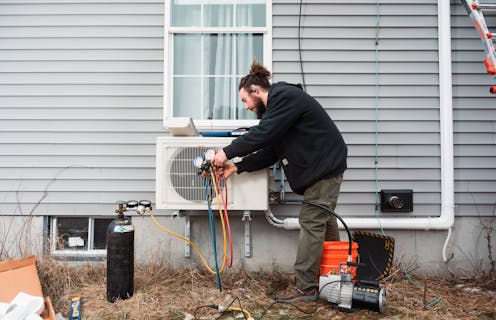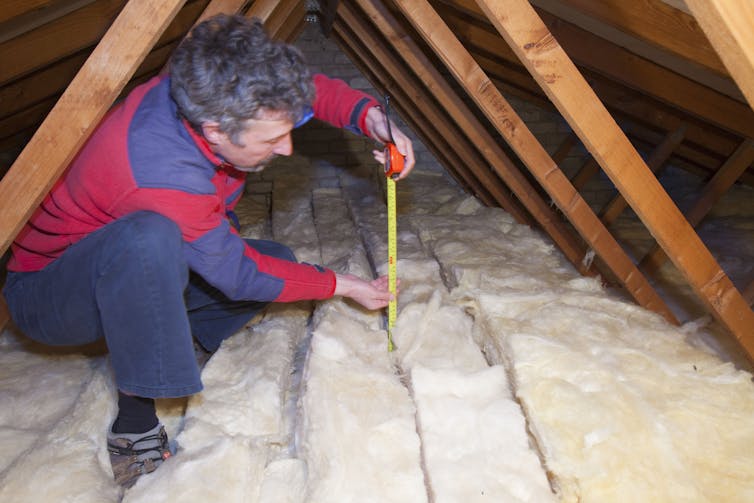Carbon offsets can help bring energy efficiency to low-income Americans − our Nashville data shows it could be a win for everyone
- Written by Zdravka Tzankova, Associate Professor of the Practice in Climate & Environmental Studies, Vanderbilt University
 Replacing windows and adding a heat pump in place of a furnace can save energy, reducing emissions.Tristan Spinski for The Washington Post via Getty Images
Replacing windows and adding a heat pump in place of a furnace can save energy, reducing emissions.Tristan Spinski for The Washington Post via Getty ImagesUnder pressure from customers and investors, many U.S. companies have pledged to voluntarily reduce their impact on the climate. But that doesn’t always mean they’re cutting their own greenhouse gas emissions.
A large number of companies are instead paying others to reduce carbon emissions on their behalf through projects that generate carbon offsets.
There are reasons for skepticism about this practice. Chief among them is that projects developed for carbon offsets have a history of taking up land in poorer countries, displacing small-scale farmers and threatening livelihoods in the process. The quality of some globally traded voluntary offsets has also proven challenging to verify. Investigations of forest-offset projects, for example, have suggested that many aren’t as effective at sequestering carbon as they claim.
We think there is a better solution: Companies could spend some of their carbon-offset money on climate-friendly projects that don’t just cut emissions but also improve people’s lives in the U.S. communities where these companies operate.
Ourteamat the Climate, Health and Energy Equity Lab at Vanderbilt University has been exploring the possibility of corporate offset dollars paying to improve energy efficiency in low-income housing, starting with a pilot study in our hometown of Nashville. Efficiency upgrades can save energy and money and reduce carbon emissions. At the same time, they reduce some of the many health risks created or elevated by living in a home that is hard to properly heat and cool.
Such upgrades can be financed by selling carbon offsets on the “social carbon” segment of the voluntary carbon market. The combined economic, health and climate benefits of low-income energy upgrades could make these projects attractive for companies seeking to fulfill their climate commitments and earn positive attention in the local community.
Energy efficiency pays off in many ways
On average, low-income households in the U.S. spend 6% to 10% of their income on energy costs. Often, these renters and homeowners are struggling to keep aging, poorly insulated homes at healthy temperatures.
For some people, the cost of heating a home can get so high it becomes a choice of “heat or eat,” which can take a physical and mental health toll.
In Nashville, we looked at implementing four key types of energy efficiency upgrades in low-income housing. Together, they can reduce energy use and energy-related carbon emissions while also earning offset credits on the voluntary carbon market.
We calculated that the combination of upgrading the windows, refrigerator and heating and cooling system and also insulating the attic in a two-bedroom Nashville rental unit could reduce its carbon emissions from home energy use by an estimated 592 tons over the 25-year life of the upgrades.
If carbon reductions from upgrades to that Nashville home were packaged as carbon offsets and sold on the voluntary carbon market at US$30 to $45 per ton, the money earned could cover the substantial material costs for the energy efficiency upgrades. This pricing is consistent with prices commanded by other carbon offsets with significant and meaningful social benefits. It is also quite possible that the community health benefits would be more attractive to some corporate buyers than the carbon reductions themselves. The offset transactions can be facilitated by nonprofits, social enterprises or local governments.
Many of these upgrades are prohibitively expensive for low-income households without outside financial help. They also tend to be avoided by landlords, since it is tenants, not landlords, who pay the utility bills.
Lessons from Maine and the Southeast
Projects are already mobilizing carbon-offset funding for renewable energy and energy efficiency in the U.S.
One of the early innovators was the Maine State Housing Authority. The agency piloted financing residential energy efficiency upgrades with the sale of carbon offsets in the early 2000s and discovered how complicated the process can be.
Chevrolet’s $750,000 purchase of carbon credits from the Maine project in 2012 enabled efficiency upgrades to about 170 homes. The project revealed some important lessons, including the need for a large number of homes and a high carbon price for the project to pay off. A 2012 review of the program noted that, while each house could generate hundreds of dollars in carbon credits, setting up the project, measuring and validating the value, and selling this type of offset can cost tens of thousands of dollars before the work on homes begins.
To lower that cost, Maya Maciel-Seidman, a member of our team, developed a way to quantify carbon reductions from home energy upgrades. She was able to reduce the time and cost by relying on publicly available utility and government data combined with easy to perform on-the-ground measurements.
 Insulating attics can save hundreds of dollars a year on energy bills and pay off quickly.Ashley Cooper/Construction Photography/Avalon/Getty Images
Insulating attics can save hundreds of dollars a year on energy bills and pay off quickly.Ashley Cooper/Construction Photography/Avalon/Getty ImagesAnother challenge this type of carbon offset – and offsets that support clean energy geneartion – can run into is the question of additionality: Would low-income energy upgrades happen anyway, without funding from carbon offsets?
We don’t think so. There are federal programs that provide funding for energy efficiency upgrades in low-income housing. However, the 40-plus-year track record of the federal Weatherization Assistance Program and Low-Income Home Energy Assistance Program suggests the vast majority of eligible low-income households aren’t reached by these programs.
A solar startup in the U.S. Southeast offers another example of carbon offsets with environmental and economic co-benefits close to home. Clearloop generates carbon offsets by building utility-scale solar farms in the dirtiest parts of the U.S. electric grid, regions with little renewable energy and highly polluting power plants. The company finances solar developments through the up-front sale of carbon offsets representing the emissions saved during the lifetime operation of each solar farm.
Companies and residents benefit
Using carbon offsets isn’t a substitute for reducing emissions, or for public policies and funding aimed at eradicating energy poverty and insecurity. But we believe that mobilizing the voluntary carbon market to finance energy efficiency upgrades in low-income homes could offer meaningful relief to many households.
The physical proximity to corporate supporters of such projects should also allow for greater transparency and accountability. When companies purchase carbon offsets that are locally generated and bring additional benefits to their host communities, they bolster their social license to operate while making progress toward meeting climate commitments.
Zdravka Tzankova has informally collaborated with Clearloop in discussions of carbon offsets and classroom projects, all pro bono and educational. Neither Tzankova nor her lab have any financial ties to the company. As of 2024, Vanderbilt University is purchasing some carbon offsets from Clearloop.
Carol Ziegler is affiliated with Recycle and Reinvest, 501C3 as a Board Member, as well as the Tennessee Urban Forestry Council as a Board Member.
James Muchira does not work for, consult, own shares in or receive funding from any company or organization that would benefit from this article, and has disclosed no relevant affiliations beyond their academic appointment.
Authors: Zdravka Tzankova, Associate Professor of the Practice in Climate & Environmental Studies, Vanderbilt University

